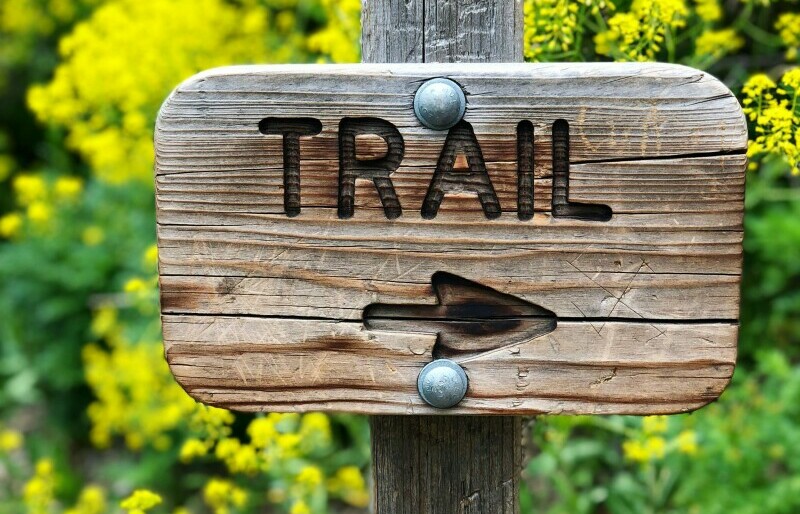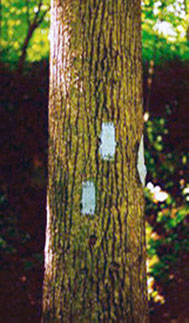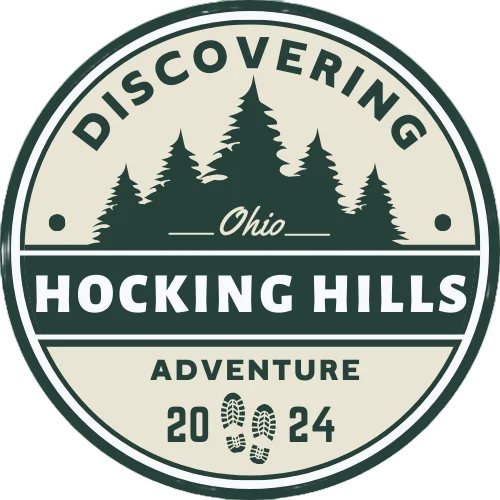Trail blazing or way marking is the practice of marking outdoor paths or trails with signs, markings, or symbols to indicate the direction of the trail.

In the early days, a blaze meant “a mark made on a tree by slashing the bark“, but has since evolved into several ways of marking trails, including paint, carvings, affixed markers, posts, flagging, cairns, and crosses. Paint is the most widely used, and that is the case here in Hocking Hills as well. So let’s jump into it and learn how to read trail markers while hiking in Hocking Hills.
Trail markers are more than just splashes of paint or stacks of rocks along your path. They’re your silent guides while venturing through the natural beauty of Hocking Hills, ensuring you stay on track and make it back safely. Consider them the bread crumbs that Hansel and Gretel should have used instead of something a bird could eat!
Another benefit of trail markers is preserving the integrity of the trail and minimizing human impact on the surrounding ecosystem. Trail markers can help you gauge your progress, estimate distances, and stay on the right path without trampling through sensitive habitats.
Understanding how to read these markers is important for a successful Hocking Hills hiking adventure. In the next section, you’ll learn what each symbol means, how color-coding works, and even the interesting regional differences that can switch things up on you. Stick with me, and you’ll be fluent in trail marker language in no time.
Deciphering the Language of Trail Markers

Now that you’ve got a handle on the importance of trail markers and how they contribute to your hiking experience, it’s time to learn the lingo. Trail markers aren’t just random signs; they’re a communication system that, when understood, can make the difference between a hike that’s memorable for all the right reasons and one that’s… let’s say, more adventurous than planned.
Most trails use a combination of symbols, shapes, and colors, working much like a universal language to guide you. You’ll find that many trail markers use simple symbols like arrows, crosses, rectangles, or even painted dots. Arrows point you in the right direction, crosses often indicate a ‘wrong way,’ and dots can signify a point of interest or transition in the trail.
If you’ve ever noticed that hiking trails often have color-coded blazes painted on trees or rocks, you’re seeing a system in action. These color codes aren’t random; each one has a specific meaning. For example, blue might signify a water trail or a scenic overlook, while red could denote a main trail. Different regions uses colors differently. By paying attention to these colors, you’ll get an idea not just of where to go, but what you might find along the way.

Take, for example, the famous 1400+ mile Buckeye Trail in Ohio, several miles of which cut directly through Hocking Hills. This trail is identified by blue blazes, 2″ wide by 6″ high, on trees or poles. A single blaze marks the trail where the route is fairly straight or obvious, while a double blaze marks a turn with the upper blaze offset to indicate the new direction.
A double blaze can also indicate a sharp turn in the trail ahead. Often, this will be two different colors side-by-side to indicate the color of each trail. Pay attention!
You might also notice different colored double blazes stacked on top of one another. This means you are traveling along two trails that overlap each other. This is common with many trails in Hocking Hills because the Buckeye Trail cuts through several major park areas.
In the example picture to the right, the two blazes indicate a turn. But in which direction? Imagine a straight line going through both rectangular blazes. The result would be an axis pointing in the direction of the turn – in this case, the trail goes to the right.

In practice, you should read trail blazes from the bottom to the top. This helps understand where you are in relation to any changes further up the trail.
While trail markers are generally designed to be straightforward, they’re used sequentially. So, when following trail markers, it’s crucial to move from one to the next in the order they appear. This process prevents you from losing your way, assuming that the trail markers are correctly maintained and visible.
It’s also worth noting that not all trails stick to the same marking conventions. Depending on where you are in the world, or even within a country, the way trails are marked can vary significantly. That’s why I suggest doing a little research on the trail marking system used in your hiking location before you set out. Knowing these small, yet critical details can ensure that your hike stays on track, both literally and figuratively.
A good tip before hiking in Hocking Hills, is to visit the Hocking Hills State Park Visitor Center at Old Man’s Cave, or a HHTA Welcome Center. There you can obtain trail maps and details about the trail marking systems used where you are planning to explore.
Common Pitfalls and How to Avoid Them
Navigating trails is usually straightforward when the markers are clear, but nature isn’t always so accommodating. Even the most seasoned hikers can get thrown off by natural formations that look deceptively like trail markers.
Weather can wreak havoc on trail markers, obscuring painted blazes or knocking down cairns. Vandalism, although less common, also poses a real problem. Keep a trail map handy as a backup, and it never hurts to know the basics of using a compass. Don’t worry too much about mastering orienteering skills, but familiarize yourself with the basics of these tools just in case.
The last thing I want is for you to get lost because a trail marker went missing. You can always cross-reference your position with the map or a GPS device if you suspect you’ve gone off track. Choose something that resonates with you, whether it’s a high-tech app or an old-school paper map.

A Handheld GPS Navigator Serves as a Trail Guide and Compass!
Now, this isn’t just about finding your way; it’s also about staying safe. In my opinion, the best approach to trail navigation combines tech-savviness with a good old-fashioned sense of direction. Ready for another gold nugget of advice? Your first attempt doesn’t need to be your last. That’s the strategy I like to leverage when teaching navigation techniques: stay flexible and learn as you go.
Respecting Trail Markers: Leave No Trace Principles

You’ve learned how to read trail markers and navigate your path confidently. But there’s one more chapter in this story: respecting what you’ve used to guide you. The ethics of hiking go hand in hand with respecting trail markers. These symbols not only show us the way but also protect the natural environment by keeping us on established paths.
What if you come across a damaged or misplaced marker during your hike? Don’t just shrug off. If you can do so safely, fix the marker to its correct position. If it’s beyond a quick fix, note the location and inform the trail management or local authorities once you’re back. In Hocking Hills, you can always contact the park office to let them know.
Your responsibility doesn’t end there. As someone who appreciates the great outdoors, it’s crucial to pass on what you’ve learned. When you meet new hikers or those unfamiliar with trail markers, share your knowledge. Better yet, share this article! Educate them not just on how to read the markers but also on the importance of preserving them.
Finally, embracing the Leave No Trace (LNT) philosophy is essential. Travel on designated trails, dispose of waste properly, and minimize the impact of your visit. If you packed it in, pack it out with you! Remember, trail markers are a shared resource designed to help every hiker have a safe and enjoyable adventure without leaving a detrimental footprint on the natural world.
Take Nothing But Pictures, Leave Nothing But Footprints, Kill Nothing But Time
** A bit of transparency: Our website contains affiliate links. When you click through and purchase a product or service through any of our links, we may receive a small commission. Don’t worry, there is no extra cost to you. It’s a simple way you can support our mission to keep Discovering Hocking Hills and bringing you quality content to make your escape to Hocking Hills unforgettable! **
